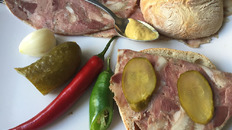Meats and Sausages
Italian Head Cheese
| Meats | Metric | US |
|---|---|---|
| pork heads (with bones) | 750 g | 1.65 lb. |
| beef heads(with bones) | 120 g | 0.26 lb. |
| pork skins | 130 g | 0.28 lb. |
Ingredients per 1000g (1 kg) of meat
| salt | 18 g | 3 tsp. |
| pepper | 4.0 g | 2 tsp. |
| caraway seeds | 4.0 g | 2 tsp. |
Instructions
- Poach meats in a small amount of water: pork heads at 85°C (185°F), beef head meat and pork skins at 95°C (203°F)
- After poaching remove meat from heads and spread all meats apart on a flat surface to cool. Save meat stock.
- Boiled pork head meat: cut into strips 1.5 x 2 cm (⅝ x ¾”) by 7-10 cm (2 x 4”); boiled beef head meat: cut into strips 1 x 5 cm (⅜ x 2”); boiled skins and tougher meat parts: grind with 3 mm (⅛”) plate.
- Mix all meats with spices adding 10% of meat stock in relation to the weight of pork heads with bones. The meat stock is the result of boiling pork heads.
- Stuff mixture not too tight into hog stomachs or beef bungs about 12” (30 cm) long, 8” (20 cm ) wide and 3” (8 cm) thick. Saw the ends with butchers twine.
- Poach head cheeses at 180°F (82°C) for 90-150 min (depending on size) until the internal temperature of the meat reaches 154-158°F (68-70°C). Remove air with a needle from pieces that swim up to the surface.
- Spread head cheeses on a flat surface at 2-6°C (35-43°F) and let the steam out. Then flatten them with weight and cool them to below 6°C (43°F).
- After cooling clean head cheeses of any fat and aspic that accumulated on the surface, even them out and cut off excess twine. Store in refrigerator.
Notes
Commercial producers will cure heads with nitrite in order for meat to develop a pink color.


















